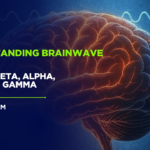Note: I’m mainly a researcher, not a professional writer, and English isn’t my first language. Please excuse any grammar mistakes or unpolished phrases you might find.
Frequencies and Patterns
Sound waves have different frequencies. These frequencies, measured in hertz (Hz), range from 20 Hz to 20,000 Hz. These frequencies organize matter in ways that show how important vibration is in nature. Neurahz explores how these patterns form and what they might tell us about the universe.
The Neural Dance
The brain is full of electrical activity, and it creates patterns called brainwaves (or neural oscillations) that show what we’re thinking or feeling. For example, during deep sleep, the brain mostly uses delta waves (0.5–4 Hz). Theta waves (4–8 Hz) are linked with creativity, alpha waves (8–12 Hz) show relaxation, beta waves (12–30 Hz) are connected to alertness, and gamma waves (30–100 Hz) are active when we’re very focused. Interestingly, sound can actually help these brainwaves get in sync using brain entrainment. That means outside rhythms can influence brain activity, helping us relax, focus, or even dream better.
A study in 2018 found that a 4 Hz auditory rhythm can actually help our brains produce theta waves, which are linked to memory and creativity. Music’s rhythmic patterns trigger the release of dopamine, a neurotransmitter that makes us feel good and motivated. So, it seems like sound frequencies can have a subtle effect on our brains, influencing our mood, thinking, and even how our brains change and adapt over time.
Cymatics
Sound waves possess an ability to organize physical matter. When sound waves vibrate a surface, such as a plate covered in sand, they generate visually stunning geometric patterns. These patterns can form as circles, grids, or spirals, all contingent on the frequency of the sound. A study conducted in 2019, published in Physical Review E, looks into the mechanism behind these patterns. It reveals that the interaction of sound waves imposes order on the chaotic energy, transforming disorder into order, from the smallest sand grains to larger systems.
Sound waves can actually shape matter, which raises the question of whether similar vibrational patterns also affect living things or the environment. For example, low frequency sound waves can create a sense of depth in physical spaces, as shown in a 2019 study by the Journal of the Acoustical Society of America. These interactions suggest that vibrations might play a role in how things are built, from the structure of sand to the patterns of life on Earth.
Quantum and Universal Contexts
In quantum physics, tiny particles can also behave like waves, each with its own frequency. And string theory goes even further, saying that the smallest parts of everything are tiny strings that vibrate, and how they vibrate decides what kind of particle they become. Even though string theory isn’t proven, it still gives the idea that vibration might be a basic rule of how the universe works. It makes you wonder if sound patterns are actually showing us something deeper about how things are organized.
There’s no solid proof yet that sound frequencies can cause quantum level vibrations, or that brain activity has any effect on big cosmic structures. But it’s still a very interesting idea to think about. Can the rhythms that affect our brainwaves or make patterns in sand also show up in the tiniest particles or even across galaxies? Neurahz takes this question seriously. We look into it through science, but we don’t try to claim anything that isn’t backed by real evidence.
The Purpose of Neurahz
Neurahz looks into how sound frequencies affect both the brain and the physical world, always with practical use in mind. Things like entrainment and neuroplasticity show that sound might help with focus, lower stress, and even support brain healing. Cymatics also shows how vibrations can shape matter, which gives us clues about how frequencies might affect bigger systems too.
By mixing neuroscience, physics, and sound, Neurahz works on tools and ideas that are backed by real data. We focus on things like frequency-based therapy and studying vibration patterns, but always keep the research grounded.


